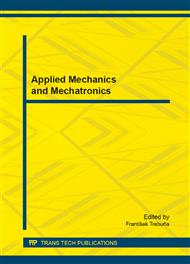p.284
p.294
p.304
p.311
p.316
p.325
p.332
p.339
p.346
Early-Stage Design of Robotic Manipulator Using Dual Visual Perception
Abstract:
Many service mobile robots have an articulated robotic manipulator mounted on their platform. The mobile platform extends the workspace of the arm, whereas the arm offers several operational functionalities. The basic idea is to mount two cameras to the robotic arm. One camera provides the perception of the surrounding environment and navigation of the robot, the second one located on the robot arm provides for the perception of the object of cooperation. This paper deals with an early-stage design process of the mentioned robotic manipulator using dual visual perception. It includes kinematic, dynamic and stress-strength analysis. For the kinematic analysis the homogeneous matrix method and for dynamic analysis the Newton-Euler method has been used. These analyses are required for control solution.
Info:
Periodical:
Pages:
316-324
Citation:
Online since:
August 2014
Keywords:
Price:
Сopyright:
© 2014 Trans Tech Publications Ltd. All Rights Reserved
Share:
Citation:


